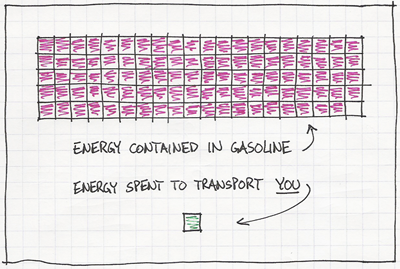This is something I’ve had stuck in my mind ever since I read the book “Stuff: The secret lives of everyday things” (or was it “Natural Capitalism”? I’ve lent out both books right now).
Take a wild guess at how much of the energy in the gas you put in your car actually goes towards transporting you. Don’t be afraid to lowball it. Write it down.
How did you go about it? Did you use the fact (which is fairly common knowledge) that car engines are about 30% efficient? Good. But 30% is not the answer. Did you pay attention to how the question is worded? “Towards transporting YOU”?
How about idling, energy lost in the driveline, energy lost on powering accessories in the car? With all that, about one-eighth (12.5 %) of the energy reaches the wheels. Around half of that heats the tires, road and air that the car pushes aside. That leaves about 6% or so applied to moving the car forward. When you figure in that your mass compared to the car’s mass is about 5%, that leaves less than one percent of the energy in the fuel for transporting YOU. Let’s be generous and say it’s actually one percent. Here’s a little visual of that number for you:
That’s a scary waste in my book.
Here’s more to make you think: A friend of mine, Stan King, did some calculations based on a discussion we had at a recent simplicity circle meeting at our house. I had wondered how bicycling compares to driving in terms of energy efficiency. He took on the task of figuring it out. When you convert the amount of energy needed to bike a mile and convert that to the car’s miles-per-gallon equivalent, riding a bicycle has a “miles-per-gallon” of about 650. That number makes hybrid cars pale in comparison.
When you consider that 99% of the energy in the gas is wasted on things other than transporting you, the passenger, riding a bicycle has a “miles-per-gallon” of over 6500.
Compared to that, hybrid cars seem almost like stone age technology.
This is the thinking behind our family’s decision to stick with one car, even though it creates some inconvenience. It’s also why I bike to work practically every day.
And just so you won’t think I pulled these numbers out of thin air, there’s a Wikipedia article that states a 653 mpg for bicycling, which matches Stan’s number well. The calculation on the efficiency of cars can be found in this article by Amory Lovins from July 2006. The journal this was published in can be downloaded here (3.17 MB PDF).

Pearl Jam
GeekTieGuy
Pearl Jam
Leila
Keesa
GeekTieGuy
Peter
Eli
JohnM
Mark Foecking
Pingback: Practicing What You Preach | Ride Earth
Draught Excluder
Pingback: Practicing What You Preach | Slow Quest